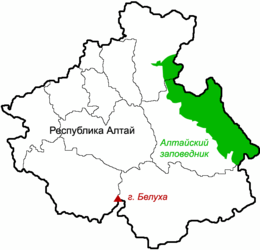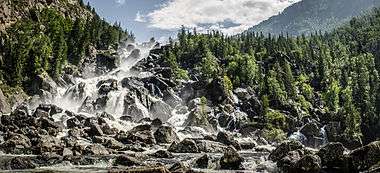Altai Nature Reserve
| Altai Nature Reserve | |
|---|---|
|
Russian: Алтайский заповедник (also, "Altaisky") | |
|
IUCN category Ia (strict nature reserve) | |
|
Katu-Yaryk pass, Altai Zapovednik | |
 Location of Reserve | |
| Location | Altai Republic |
| Nearest city | Gorno-Altaysk |
| Coordinates | 51°34′0″N 87°45′0″E / 51.56667°N 87.75000°ECoordinates: 51°34′0″N 87°45′0″E / 51.56667°N 87.75000°E |
| Established | 1932 |
| Governing body | Ministry of Natural Resources and Environment (Russia) |
| Website | http://www.altzapovednik.ru/ |
Altai Nature Reserve (Russian: Алтайский заповедник, also called Altaisky) is a Russian 'zapovednik' (sanctuary, strict nature reserve) in the Altai Mountains of south Siberia, Russia. It is part of the UNESCO World Heritage Site "Golden Mountains of Altai", recognized as an area of high biodiversity and isolation from human intrusion. It is also included in the UNESCO World Network of Biosphere Reserves. The Altai Reserve includes the 30 km-long east bank of Lake Teletskoye and stretches 230 km into the high mountains to the southeast of the lake. It is situated in Ulagansky District and Turochaksky District in the north and east of the Altai Republic.[1][2]
Topography
The reserve has an elongated shape running from the northeast to southwest along the Teletskoye basin and into the high interior. Elevations rise to 3,500 metres (11,500 ft). This territory average 35 km wide through its 230 km length. Lake Teletskoye is in the upper northwest end. The Chulyshman River runs into the lake, with the Chulyshman valley forming part of the western border of the Altia Reserve. Most of the reserve is the plains and alpine ridges of the Chulyshman Highlands. Over 20% of the territory is rock, scree and gravel. On the high plateaus there are over 1,000 alpine lakes greater than 1 hectare in size.[1][2]


Climate and ecoregion
Altai is located in the Sayan montane conifer forests ecoregion. This ecoregion is characterized by mountains dissected by river valleys, high levels of precipitation, and high biodiversity. Flora is generally dependent on the elevation and terrain, with forest having three main subzones based on altitude: light needle-leaf sparse taiga, dark needle-leaf taiga, and dark taiga. The Altai reserve has been for the most part undisturbed by human activity, and is one of the few remaining pristine areas of this ecoregion. It covers 9.4% of the entire Republic of Altai, and there are no roads in the reserve.[2][3][4]
Altai has a Subarctic climate (Köppen climate classification Dfc). This climate is characterised by long cold winters, and short, cool summers. Over the past 50 years in the Altai reserve, the warmest month has been July (+16,8 °C), the coldest month (January -8,3 °C), and the average rainfall has been 865 mm.[1][5]
Flora and fauna
The most common trees in the Altai Reserve coniferous species: larch, Siberian, Siberian cedar and Siberian fir. On the slopes near Lake Teletskoye there are some secondary forests of birch and alder, but most of the reserve to the south is untouched - cedars on the site have been measured up to 1.8 meters in diameter and 400–450 years in age.Scientists at the reserves have recorded over 1,500 species of vascular plants, including 22 species listed as 'vulnerable' in the Red Book of the Russian Federation.[1] There are over 70 species of mammals in the reserve, including two endangered species, the Snow Leopard and the Altai argali. There are 19 species of fish, mostly in Lake Teletskoye, including pike, perch, and whitefish. In the streams the most common fish is the grayling. Of the 331 species of birds found in the reserve, most (48%) are passerine (159 species), waders (48 species), Falconiformes (30 species), and geese (29 species). The remaining 66 species account for only 20%.
Ecotourism
As a strict nature reserve, the Altai Reserve is mostly closed to the general public, although scientists and those with "environmental education" purposes can make arrangements with park management for visits. There are six "ecotourist" routes in the reserve, however, that are open to the public, but require permits to be obtained in advance. Park management recommends allowing 2–3 months in advance for obtaining permits. The main office is in the city of Gorno-Altaysk.[1]
The six ecotourist routes open to the public (permits required) are:
- Chichelgansky Zigzag. Overlook of Lake Teletskoye, ethno-cultural visitor center, Yaylyu waterway hike. (website (in Russian)
- Belinskaya Terrace. Ancient monuments of the Turkic period - "Kaeser-Tash" (stone warrior), "IT-Bash" (stone-dog). (website (in Russian))
- Corbou Waterfall . 25 km boat ride and hike. 13 meter waterfall. (website (in Russian))
- Cordon Chelyush - Waterfall. Softwood forest, overviews of Altai. (website (in Russian))
- Kokshe Waterfall. Orientation by reserve ranger, hike to Kokshe Waterfall on the Koskhe River (largest right bank tributary of Lake Teletskoye. (website (in Russian))
- Great Falls of the Chulchinsky. Hike for experience mountain hikers only. (website (in Russian))
See also
References
- 1 2 3 4 5 "Altai Zapovednik (Official Site)" (in Russian). Ministry of Natural Resources and Environment (Russia). Retrieved January 21, 2016.
- 1 2 3 "Altai Zapovednik" (in Russian). Ministry of Natural Resources and Environment (Russia). Retrieved January 21, 2016.
- ↑ "Sayan montane conifer forests Ecoregion". Global Species.org. Retrieved January 21, 2016.
- ↑ "Sayan montane conifer forests". Encyclopedia of Earth. Retrieved January 23, 2016.
- ↑ "Climate of Altai". GloalSpecies.org. Retrieved January 21, 2016.
External links
- Official Website, Altai Nature Reserve (In English)
- Maps of the Reserve and Surrounding Protected Areas
- Video Gallery, Altai Biosphere
- Map of Altai Nature Reserve at OpenStreetMap
- Map of Altai Nature Reserve at ProtectedPlanet.org
| Wikimedia Commons has media related to Altaysky Nature Reserve. |
